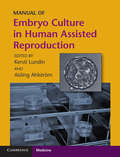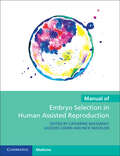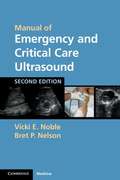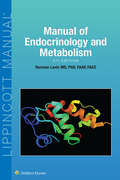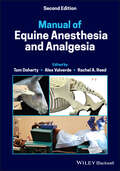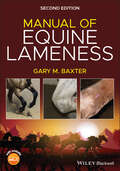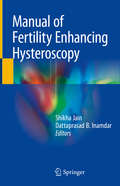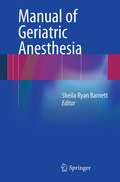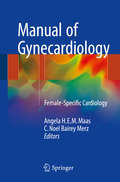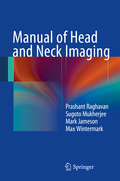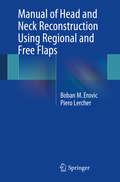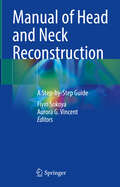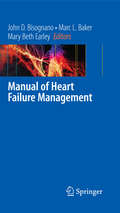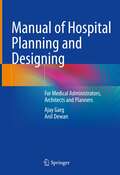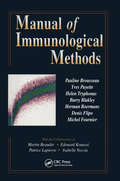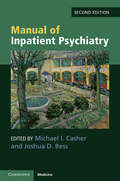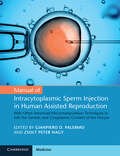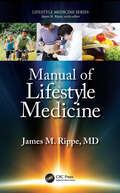- Table View
- List View
Manual of Embryo Culture in Human Assisted Reproduction
by Kersti Lundin Aisling AhlströmWhilst assisted reproduction techniques (ART) have become increasingly successful and largely standardized, there is still only a partial understanding of what constitutes a 'true' embryo environment. Replicating the varying physiological conditions of the in-vivo environment that the embryo travels through in the in-vitro culture is still a major challenge in ART. This practical volume details how to organize and operate an IVF laboratory in order to mimic these conditions for successful embryo culture. Environments and equipment that are essential for running safe and efficient facilities such as maintaining good air quality and hygiene protocols, and utilizing an effective layout are covered in detail. Other chapters discuss the different consumables needed, optimal handling techniques and parameter monitoring systems, as well as recent advances in the area including artificial intelligence and automation. This is an indispensable guide to understanding the background science of culturing embryos, crucial to successful outcomes in ART.
Manual of Embryo Selection in Human Assisted Reproduction
by Catherine Racowsky Nick Macklon Jacques CohenSelecting the best embryo to transfer to the uterus is key to successful in vitro fertilization (IVF). A huge amount of research has been devoted to this topic and there are numerous methods used, from simple morphological assessment to molecular biological techniques to assess the genome and metabolism of the newly fertilized embryo. For many of these techniques, an adequate evidence base is lacking, and expert opinion is valuable. Clinical imperatives require ranking all embryos in a cohort according to their viability, thereby enabling the selection of the best embryo to optimize live birth outcome: a key indicator used to measure and rate IVF Clinics worldwide. This clear and informative manual will provide embryologists and clinicians with an overview of the tools now available to assist in embryo selection, as well as evidence for their efficacy and safety and the broader considerations that must underlie these important clinical decisions.
Manual of Emergency and Critical Care Ultrasound
by Vicki Noble Bret NelsonUltrasound has revolutionized a physician's ability to make urgent and emergent diagnoses at the bedside, and has changed the management of many acute injuries and conditions. This is a practical, concise introduction to what is rapidly becoming an essential tool for all critical care physicians: bedside emergency ultrasound. The Manual covers the full spectrum of conditions diagnosed using ultrasound and gives practical guidance in how to use ultrasound for common invasive procedures. Major applications are introduced using focused diagnostic questions and reviewing the image-acquisition skills needed to answer them. Images of positive and negative findings are presented, and scanning tips for improving image quality. The second edition has been substantially revised and expanded, with new images, updated literature reviews, new applications and clinical algorithms. New chapters cover additional procedures, musculoskeletal and pediatric applications, and the use of ultrasound in resuscitation. This text is invaluable for emergency physicians at all levels.
Manual of Endocrinology and Metabolism (Lippincott Manual Series)
by Norman LavinIdeal for all health care professionals who evaluate, diagnose, treat, or refer patients with endocrine disease or disorders, Manual of Endocrinology and Metabolism, Fifth Edition, brings together nearly 150 global authorities who share their knowledge and expertise on endocrine disorders in children, adolescents, and adults. Using a concise outline format, this thoroughly updated manual presents clinical information and protocols needed in everyday practice, with an emphasis on diagnosis and treatment. Succinct chapters and an abundance of tables and diagrams make complex information easy to find and understand.
Manual of Equine Anesthesia and Analgesia
by Tom Doherty Alex Valverde Rachel A. ReedA fully updated new edition of this practical guide to managing anesthesia in horses and other equids, providing updated and expanded information in a concise, easy-to-read format Manual of Equine Anesthesia and Analgesia provides practitioners and veterinary students with concise, highly practical guidance to anesthetizing horses, donkeys, and mules. Using a bulleted quick-reference format, this popular resource covers the basic physiological and pharmacological principles of anesthesia, patient preparation and monitoring, and the management of sedation and anesthesia. Chapters written by leading veterinary anesthesiologists contain numerous clinical images and illustrations, case examples, tables, diagrams, and boxed summaries of important points. Now in full color, the second edition features extensively revised and updated information throughout. New sections cover chronic pain, management of horses undergoing MRI, ventilators, nerve blocks for reproductive surgery, muscle relaxants, various new drugs, paravertebral anesthesia, treatment of pain using acupuncture and physical rehabilitation techniques, and more. Up-to-date appendices contain drug lists and dosages as well as equations related to equine cardiovascular and respiratory systems. This concise, easy-to-follow guide: Provides practical, clinically oriented information on anesthetizing equids Uses a bulleted format designed for fast access of key information Offers step-by-step instructions and diagrams of nerve blocks of the limbs, head, and ophthalmic structures Includes new coverage of topics including regulation of extracellular fluid and blood pressure, acid-base disorders, and hemodynamic effects of autonomic drugs Manual of Equine Anesthesia and Analgesia, Second Edition, remains a must-have resource for all equine practitioners and veterinary students involved with anesthetizing horses.
Manual of Equine Dermatology
by Dr Rosanna MarsellaThis book deals exclusively with the equine dermatological problems that the clinician would see in practice. It is the perfect reference for the practitioner who must quickly diagnose and treat the problems. Illustrated in color throughout, coverage progresses from the approach to a case which covers history, signalment, identification of primary vs secondary lesions, distribution of lesions, with examples of differential diagnoses based on the detection of specific lesions to therapy and to chapters of diseases organized by presenting problems and signs - pruritus, allergy, parasitic, crusting, nodules, ulcerative and regional. Over 90 color images together with tables and flow charts provide quick access to important diagnostic and treatment information.
Manual of Equine Lameness
by Gary M. BaxterManual of Equine Lameness provides essential information on equine lameness diagnostics and treatment in an easy-to-use format ideal for the clinical setting. A clinically relevant distillation of topics from Adams and Stashak's Lameness in Horses, this text offers a quick introduction and fast access to key information. An accompanying DVD includes practical supplements, including additional anatomical images, video clips demonstrating key procedures such as perineural and intrasynovial injections, and examples of lameness conditions in motion. Designed for use in daily practice, the book is presented in brief chapters carefully formatted to maximize the usefulness for practicing veterinarians. Manual of Equine Lameness is an invaluable resource to any veterinarian treating lameness in horses and an ideal reference for veterinary students wanting to learn the fundamentals of lameness.
Manual of Equine Lameness
by Gary M. BaxterMANUAL OF EQUINE LAMENESS Discover a concise and accessible guide to diagnosing and managing lameness in horses The revised Second Edition of Manual of Equine Lameness offers a concise and accessible manual of lameness diagnosis and treatment in horses. Perfect for use as a quick reference, this book provides straightforward access to the essentials of equine lameness, including the clinical assessment of the horse and commonly performed diagnostic nerve blocks and the most common conditions of the foot, forelimb, and hindlimb that may be contributing to the lameness. Current therapeutic options to treat lameness are also discussed, as well as guidance on how to manage musculoskeletal emergencies. The content has been distilled from the authoritative Seventh Edition of Adams and Stashak’s Lameness in Horses, and this new edition has been re-envisioned to be even quicker and easier to navigate than the previous version. Color photographs and illustrations support the text, which presents lameness information most relevant to equine general practitioners, mixed animal practitioners, and veterinary students. A companion website offers videos that focus on the clinical examination of the horse and select diagnostic blocks and relevant anatomy. Diagnostic and treatment material has been revised from the previous edition to include the most up-to-date information. Readers will find: A thorough introduction to the assessment of the lame horse, including history, visual exam, palpation, subjective and objective assessments of lameness, perineural anesthesia, and intrasynovial anesthesia An exploration of common conditions of the foot, including the navicular region and soft tissue injuries, coffin joint and distal phalanx conditions, and laminitis Discussions of the most common conditions of the forelimb, including the pastern, fetlock, metacarpus/metatarsus, carpus, antebrachium, elbow, and humerus, as well as the shoulder and scapula Discussions of common conditions of the hindlimb and axial skeleton A review of therapeutic options to treat lameness conditions How to manage musculoskeletal emergencies in the horse Ideal for veterinary students, early career equine practitioners, and mixed animal veterinarians, the Second Edition of Manual of Equine Lameness is an indispensable reference for any veterinarian seeking a concise one-stop reference for equine lameness.
Manual of Equine Nutrition and Feeding Management
by Carol Z. Buckhout Barbara E. LindbergManual of Equine Nutrition and Feeding ManagementS A practical manual for applied labs on the nutrition and feeding of horses In the Manual of Equine Nutrition and Feeding Management, a team of equine nutritionists and educators delivers a comprehensive manual perfect for use in an applied laboratory setting. This book explores critical ideas in equine nutrition, from plant identification to determining the cost of feeding. The laboratory concepts and assignments contained within this book combine the practical aspects of feeds and feeding with the technical aspects of equine nutrition. Each chapter is organized to include an introduction, objectives, and questions for further study; and is supplemented with additional activities to aid in the retention of the presented material. A companion website provides worksheets, with an instructor key with answers to the lab activities and assignments available to instructors. The book also includes: A thorough introduction to the equine digestive system, including the primary and secondary organs of digestion Comprehensive explorations of plant identification, pasture, hay, and concentrates for horses Practical discussions of by-product feeds and additives, including explanations of the concepts of “as sampled” and “dry matter” In-depth examinations of how to determine the nutrient content of feeds and the use of feeding standards and English-metric conversions Ideal for pre-veterinary and equine studies students, the Manual of Equine Nutrition and Feeding Management is also an indispensable resource for veterinary medicine and veterinary technician students, equine nutritionists, and the owners and breeders of horses.
Manual of Fast Track Recovery for Colorectal Surgery
by Nader Francis Robin H. Kennedy Monty G. Mythen Olle LjungqvistManual of Fast Track Recovery for Colorectal Surgery provides a broad overview on enhanced recovery, with expert opinions from leaders in the field regarding elements of enhanced recovery care that are generic and specific to colorectal surgery. This book covers the patient journey through such a programme, commencing with optimisation of the patient's condition, patient education and conditioning of their expectations. Manual of Fast Track Recovery for Colorectal Surgery investigates the metabolic response to surgery, anaesthetic contributions and optimal fluid management, after surgery. It also details examples of enhanced recovery pathways and practical tips on post-operative pain control, feeding, mobilisation and criteria for discharge. Manual of Fast Track Recovery for Colorectal Surgery is a valuable reference tool for colorectal surgeons, anaesthetists, ward nurses and other members of the team involved in perioperative care: pain control specialists, physiotherapists, dietitians, specialist therapists (such as colorectal and stoma nurses), and outpatient nurses.
Manual of Fertility Enhancing Hysteroscopy
by Shikha Jain Dattaprasad B. InamdarThis book is an illustrated and comprehensive compilation by experts in the field of fertility enhancing endoscopic surgery and assisted reproduction. This book catalogues full spectrum of diagnostic and operative hysteroscopy in the infertile population. The authors describe different techniques in various clinical conditions and review the recent evidence based literature supporting them. All procedures are explained in clear and precise text supplemented with high quality color pictures.
Manual of Geriatric Anesthesia
by Sheila Ryan BarnettThe Manual of Geriatric Anesthesia is a practical guide for physicians, residents, and students interested in the care of the elderly patient undergoing surgery. Although primarily written for anesthesiologists, other perioperative physicians and nurses will also find the information highly valuable. Highlights of the text include concise and clear discussions of preoperative assessment, anesthetic administration, the immediate postoperative care, as well as the more classic 'geriatric' topics such as the hip fracture patient, cataract surgery, postoperative delirium, dementia, ethics and end of life care. Clinical geriatric principles are woven into the text so that the reader can develop skills in geriatrics and develop a broader understanding of terminology and principles used in geriatric medicine.
Manual of Gynecardiology
by C. Noel Bairey Merz Angela H.E.M. MaasThis book provides a much-needed, internationally oriented text, focusing on specific aspects of heart disease in women. Despite the large amount of information available, there is still considerable confusion regarding female patients. As such, the book highlights the health events that occur during aging in women and that may influence the future CVD risk. For instance, pregnancy-related disorders are important predictors for CVD risk in women, and inflammatory diseases like rheumatic, thyroid disorders etc, which also interfere with CVD risk, are also more common in women. Adopting a multidisciplinary approach, including gynecology and endocrinology, it offers separate chapters on female-specific manifestations of ischemic heart disease, such as Tako Tsubo CMP and spontaneous coronary artery dissections. The book also discusses the effects and side effects of important medications. The chapters are clearly formatted, making it easy for readers to find subjects of interest.
Manual of Head and Neck Imaging
by Sugoto Mukherjee Max Wintermark Prashant Raghavan Mark J. JamesonThis book is designed as an easily readable manual that will be of great practical value for radiology and otolaryngology residents during their clinical rotations. Key facts on head and neck imaging are presented in short chapters written in an easily readable style. Line drawings are used to illustrate key concepts, and tables, checklists, and algorithms will enable the readers to arrive at a quick diagnosis. In addition, emphasis is placed on clinical pearls that will assist them in preparing suitable reports. The Manual of Head and Neck Imaging is sized to allow residents to read it completely within a matter of days, and it will also serve as an ideal quick reference guide as different clinical situations arise.
Manual of Head and Neck Reconstruction Using Regional and Free Flaps
by Boban M. Erovic Piero LercherAblative tumor surgery of the head and neck region often results in severe cosmetic and functional deformities. In these cases, microvascular free-tissue transfer enables three-dimensional reconstruction of head and neck defects. The selection of adequate donor tissue and a profound knowledge of the human anatomy and the various harvesting techniques are paramount in ensuring successful reconstruction. Reflecting current surgical approaches, this book presents the most frequently used flaps in head and neck surgery, including detailed overviews as well as their respective pearls and pitfalls. Moreover, each section contains a synopsis and pre-operative checklist. The overlay-technique merges high-quality-photographs with drawings and precisely illustrates the step-to-step descriptions of the different flap harvesting techniques, making this manual in pocket size an unique and accessible reference for both doctors in training and specialists in the field of otolaryngology, head and neck, plastic, maxillofacial and skull base surgery.
Manual of Head and Neck Reconstruction: A Step-by-Step Guide
by Fiyin Sokoya Aurora G. VincentThis text will deliver revolutionary approaches to reconstructive surgery in a clear and consistent format. Head and neck reconstruction has long been thought to be a daunting, intimidating, and tedious field of surgery. Microvascular head and neck reconstruction is one of the most advanced surgical options available for reconstruction. It is used to treat defects created by removal of tissue in the larynx, pharynx, oral cavity, salivary glands, tongue, and skin. It is also utilized in combination with chemotherapy and radiation for the treatment of head and neck cancer. Due to the disfiguring nature of the removal of these tissues, microvascular reconstruction is important to return the face, head, and neck to as normal as possible. This text reviews cutting edge surgical skills in head and neck oncologic surgery and facial plastic and reconstructive surgery. The Manual of Head and Neck Reconstruction will include step-by-step guides, with clear, illustrated, coverage of regional and distant cutaneous, muscular, osseus flaps, donor site harvest and transfer for head and neck reconstruction. The book will discuss relevant anatomy, nuances of flap design, harvesting techniques, insetting, ideal locations of flap use, and flap combinations. It will also discuss preoperative preparations, intraoperative considerations, techniques for avoiding pitfalls, and managing postoperative complications. There will be intraoperative pictures walking the audience through the surgeries in a detailed fashion, with the goal of imparting an efficient, effective surgical philosophy. Exclusively to this text, the topic of surgical maneuvers designed to improve surgical efficiency and save hours of intraoperative time, limiting patient’s time under anesthesia, will be discussed. This book was authored by experts in head and neck reconstruction trained by Dr. Yadro Ducic over the past 12 years. It is a great resource for many surgeons in the field of otolaryngology-head/neck surgery.
Manual of Heart Failure Management
by John D. Bisognano Marc L. Baker Mary Beth EarleyPractical simple reference for understanding current management of heart failure Provides pathophysiology and pharmacology to explain the key points Focuses mostly on patient management issues
Manual of Hospital Planning and Designing: For Medical Administrators, Architects and Planners
by Ajay Garg Anil DewanThis book is a one-stop resource on all the critical aspects of planning and designing hospitals, one of the most complex healthcare projects to undertake. A well-planned and designed hospital should control infection rate, provide safety to patients, caregivers and visitors, help improve patients' recovery and have scope for future expansion and change. Reinforcing these basic principles, guidance on such effective planning and designing is the key focus. Readers are offered insights into eliminating shortcomings at every stage of setting up a hospital which may not be feasible to rectify later on through alterations. Chapters from 1 to 12 of the book provide exhaustive notes on initial planning, such as detailed project reports, feasibility studies, and area calculation. Chapters 13 to 27 include designing and layout of all the essential departments/units such as OPD, emergency, intermediate care, diagnostics, operating rooms, and intensive care units. Chapters 28 to 37 cover designing support services like sterilization department, pharmacy, medical gas pipeline, kitchen, laundry, medical record, and mortuary. Chapters 38 to 48 take the readers through planning other services like air-conditioning and ventilation, fire safety, extra low voltage, mechanical, electrical, and plumbing services. Chapter 49 is for the planning of medical equipment. A particular chapter on "Green" hospital designing is included. This book is a single essential tabletop reference for hospital consultants, medical and hospital administrators, hospital designers, architecture students, and hospital promoters.
Manual of Hypertension of the European Society of Hypertension, Third Edition
by Giuseppe Mancia Guido Grassi Enrico Agabiti Rosei Konstantinos Tsioufis Anna DominiczakThe Manual of Hypertension of the European Society of Hypertension reflects emerging concepts that have the potential to impact diagnostic and therapeutic approaches to hypertension. Updating all material, this new edition also delves into a number of areas that have received heightened interest in recent years or have become a matter of debate due to the controversial interpretation of the available data. FEATURES Reflects emerging concepts impacting diagnostic and therapeutic approaches Explores background, history, epidemiology, and risk factors Describes pharmacological, nonpharmacological, and medical treatments Examines hypertension in special populations and treatment
Manual of Immunological Methods (Handbooks In Pharmacology And Toxicology Ser.)
by Canadian NetworkingThe Manual of Immunological Methods represents the collaboration of the Canadian Network of Toxicology Centers, a non-profit network of university-based scientists dedicated to research, training, risk assessment, and communication. This manual provides detailed immunological methods that can be utilized by researchers or practitioners who want to
Manual of Inpatient Psychiatry
by Michael I. Casher Joshua D. BessInpatient units treat some of the most clinically challenging psychiatric patients. Clinicians must carefully balance patients' rights with safety concerns of violence and suicide. This updated manual is compact and practical, addressing the common questions and issues clinicians face in day-to-day practice. Chapters are organised around the diagnoses found on inpatient psychiatric units, allowing readers to find their area of interest quickly. A user-friendly question and answer format anticipates commonly asked questions, and tables provide easily accessible information, including diagnostic criteria and medication effects. Incorporating advances in the field over the past decade, chapters review new treatments including ketamine use and chronotherapy, as well as the most recent evidence-based approaches for patients with borderline personality disorder. Drawing on the authors' wealth of experience, their recommendations for best practice and their treatment philosophies will be valuable for all healthcare professionals working in mental health.
Manual of Intracytoplasmic Sperm Injection in Human Assisted Reproduction: With Other Advanced Micromanipulation Techniques to Edit the Genetic and Cytoplasmic Content of the Oocyte
by Zsolt Peter Nagy Gianpiero D. PalermoFor around half of the couples who have trouble conceiving the cause of infertility is sperm-related. Intracytoplasmic sperm injection (ICSI) is the most common and successful treatment for male infertility. Here, the pioneers for the technique, along with authorities in the field, describe the underlying science of ICSI and other micromanipulation techniques. Practical advice for performing the techniques is covered in depth, including sperm selection, laser-assisted ICSI, and the use of piezo in ICSI. Examining the safety of ICSI in animal models as well as the impact of ICSI on the health and well-being of the children conceived through the procedure is discussed. This manual is an essential resource for clinical embryologists and laboratory personnel wishing to refine or develop techniques and improve outcomes.
Manual of Intrauterine Insemination and Ovulation Induction
by Richard P. Dickey Peter R. Brinsden Roman PyrzakItrauterine insemination and Ovulation induction are effective first-line treatments for infertility in many straightforward cases and are preferred by many clinicians because they are less invasive than in vitro fertilization and its variants. This is a comprehensive account of how to set up and run a successful IUI program.
Manual of Laboratory Testing Methods for Dental Restorative Materials
by Paromita Mazumdar Deepshikha ChowdhuryExplore the properties of a wide range of dental materials used in restorative dentistry with a brand-new resource The Manual of Laboratory Testing Methods for Dental Restorative Materials delivers a comprehensive and accessible review of the materials used in restorative dentistry. The book offers readers an evidence-based application of the materials and their mechanical, physical, and optical properties. Each chapter begins with key points and includes a glossary to aid in the learning and retention of the material contained within. The book also covers the methods used to study the properties and the advantages and disadvantages of various dental restorative materials as well as why they are selected. The Manual of Laboratory Testing Methods for Dental Restorative Materials will be a helpful addition to any institute library or personal collection and will cater to the needs of postgraduate dental students, researchers and academics in the fields of dentistry and material sciences.
Manual of Lifestyle Medicine (Lifestyle Medicine)
by James M. RippeThe fundamental premise of lifestyle medicine is that daily habits profoundly impact health and quality of life both in the short-term and long-term. Written by lifestyle medicine pioneer and cardiologist , Dr. James Rippe, this book provides a clinically oriented, evidence-based look into key lifestyle factors and how to prescribe them to individuals of all ages. Written for professionals working at all levels of medical and healthcare practice, this manual summarizes the major components of lifestyle medicine, from physical activity and nutrition to weight management and the avoidance of tobacco products. It includes clinical guidelines and practices for using lifestyle medicine principles to lower the risk of numerous chronic conditions. The manual also provides information on behavior change, approaches to lowering the risk of dementia, treatment of addictions and injury prevention. Features: Explains how lifestyle medicine can reduce the risk of heart disease, diabetes, cancer, osteoarthritis, dementia and many other chronic conditions. Chapters begin with bulleted key points and conclude with a list of clinical applications. Provides strategies for prescribing physical activity and helping patients improve their nutrition, lose weight if necessary and reduce stress. Includes clinically relevant sections on “Treating Addiction, Preventing Injury and Improving Brain Health”. This book provides updated and clinically targeted summaries used in conjunction with Dr. Rippe's major academic textbook Lifestyle Medicine, now in its third edition, published by CRC Press/Taylor & Francis Group, LLC.
